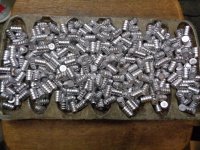My sportsmans' club has a 50' indoor rimfire range, and periodically the bullet traps get emptied, and the lead smelted down for us. We get it back in 10# ingots I believe. They keep some to cover their costs, but this is literally a multi-generational deal with a small business.
Anyway, is the likely hardness appropriate for casting 9mm, .40 and 10mm cast bullets? I know not to push cast too fast.
Completely new to reloading, and am gathering info. I know I am about 10 months too late to get primers reasonable priced. I'm thinking long term.
My brother-in-law just bought a place that is likely a mostly finished prepper compound. 50 yard range behind the barn, and less than a quarter mile from both a National Forrest and DNR lands. Both you can shoot on if you follow the rules.
Anyway, is the likely hardness appropriate for casting 9mm, .40 and 10mm cast bullets? I know not to push cast too fast.
Completely new to reloading, and am gathering info. I know I am about 10 months too late to get primers reasonable priced. I'm thinking long term.
My brother-in-law just bought a place that is likely a mostly finished prepper compound. 50 yard range behind the barn, and less than a quarter mile from both a National Forrest and DNR lands. Both you can shoot on if you follow the rules.

